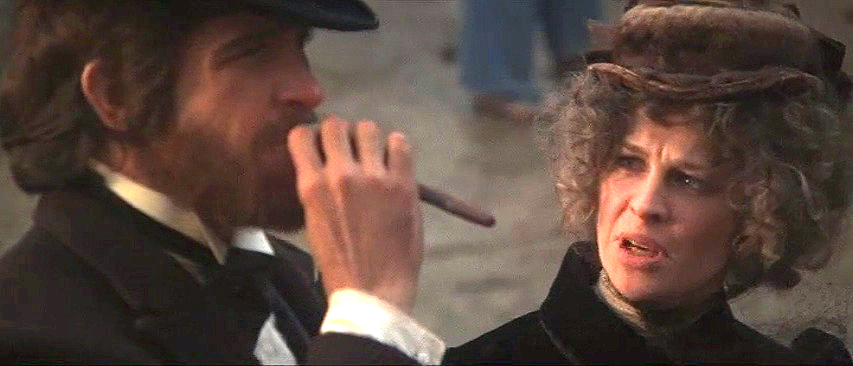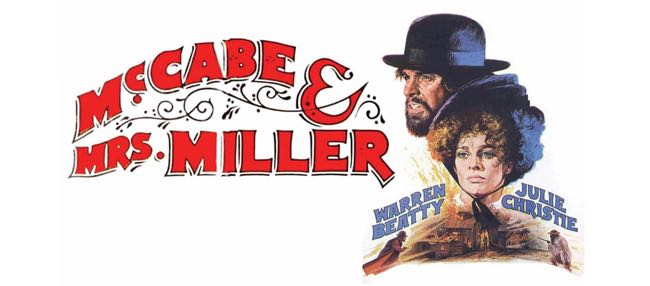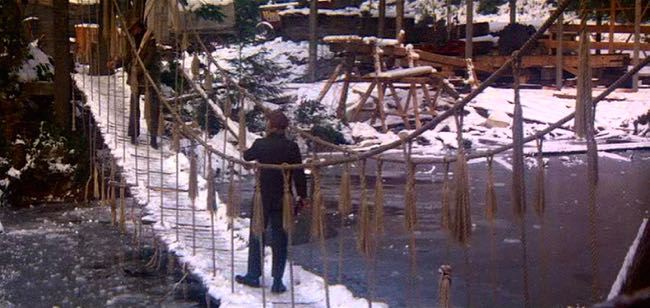By Ray Bennett
Watching the splendid new print of Robert Altman’s elegiac northwestern “McCabe & Mrs. Miller” at London’s bfi southbank, where it is playing through May 17, reminded me of why I fell in love with the film when I saw it on its release in 1971.
I went to see it 11 times then, captivated by its cinematic beauty, sly and rigorous wit, and haunting resonance as a lament for lost love and ideals. Warren Beatty and Julie Christie have never been better than in this story of a romantic gambler and naïve businessman who falls for a smart opportunist who has no illusions. When a powerful mining company wants to buy out their frontier casino and bordello, he blusters optimistically while she knows their fate is sealed. The movie has one of the shortest and saddest gunfights of all time plus a final shoot-out that also ranks with the most imaginative and suspenseful. And it all plays out to the plangent sound of Leonard Cohen’s songs on the soundtrack.
 “McCabe & Mrs. Miller” ranks at the top of the list of Altman’s truly great pictures including “MASH” (1970), “The Long Goodbye” (1973) and “Nashville” (1975), with “California Split” (1974), “Short Cuts” (1993), and “Gosford Park” (2001) not far behind. The work of cast and crew is exemplary with Vilmos Zsigmond’s cinematography in heavy snow simply breathtaking. Zsigmond, who also shot “Brewster McCloud” (1970), “The Long Goodbye” and “Images” (1972) for Altman, won the Academy Award for “Close Encounters of the Third Kind” (1977). He’s been nominated three other times, for “The Black Dahlia” (2006), “The River” (1984), and “The Deer Hunter” (1978), and did outstanding work on many other films including “Deliverance” (1972) and “Heaven’s Gate” (1980). He also shot Woody Allen’s upcoming “Cassandra’s Dream.”
“McCabe & Mrs. Miller” ranks at the top of the list of Altman’s truly great pictures including “MASH” (1970), “The Long Goodbye” (1973) and “Nashville” (1975), with “California Split” (1974), “Short Cuts” (1993), and “Gosford Park” (2001) not far behind. The work of cast and crew is exemplary with Vilmos Zsigmond’s cinematography in heavy snow simply breathtaking. Zsigmond, who also shot “Brewster McCloud” (1970), “The Long Goodbye” and “Images” (1972) for Altman, won the Academy Award for “Close Encounters of the Third Kind” (1977). He’s been nominated three other times, for “The Black Dahlia” (2006), “The River” (1984), and “The Deer Hunter” (1978), and did outstanding work on many other films including “Deliverance” (1972) and “Heaven’s Gate” (1980). He also shot Woody Allen’s upcoming “Cassandra’s Dream.”
Production designer Leon Erickson, who created the incredibly atmospheric half-built mining town of Presbyterian Church for “McCabe”, worked in various capacities including art director and associate producer on several Altman pictures. Editor Louis Lombardo, who also did the second unit direction on the picture, did many Altman pictures and also edited Sam Peckinpah’s “The Wild Bunch” (1969) and “The Ballad of Cable Hogue” (1970).
Joan Tewkesbury, who wrote the screenplay for “Nashville” and went on to direct the film “Old Boyfriends” (1979) and lots of television, was continuity and uncredited script supervisor on “McCabe.” She also appeared onscreen as one of the townswomen. Many of the cast were Altman regulars including Michael Murphy, Rene Auberjonois, John Schuck, Shelley Duvall and Bert Remsen.
Altman said that he’d wanted to cast Elliott Gould as McCabe but the actor turned him down because they’d fallen out while making “MASH.” Gould finally apologized to the director in time to make “The Long Goodbye.” But their disagreement was very good news for Beatty.
I’m not alone in my praise of “McCabe & Mrs. Miller,” witness Roger Ebert, writing in 1999: It is not often given to a director to make a perfect film. Some spend their lives trying, but always fall short. Robert Altman has made a dozen films that can be called great in one way or another, but one of them is perfect, and that one is “McCabe & Mrs. Miller” (1971). This is one of the saddest films I have ever seen, filled with a yearning for love and home that will not ever come — not for McCabe, not with Mrs. Miller, not in the town of Presbyterian Church, which cowers under a gray sky always heavy with rain or snow. The film is a poem — an elegy for the dead.”


